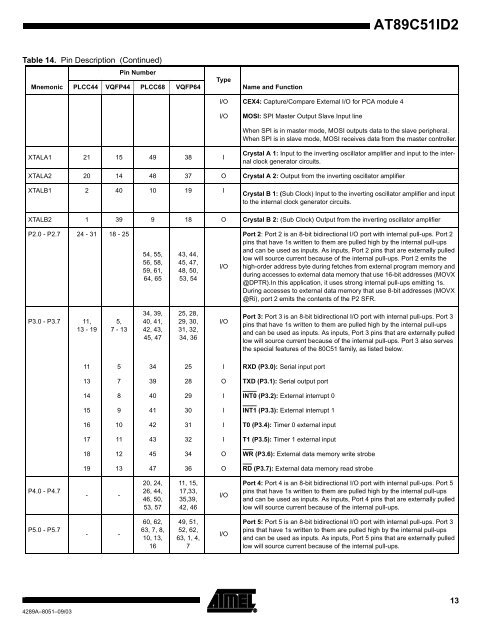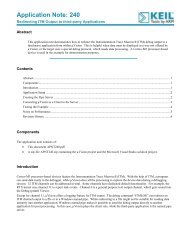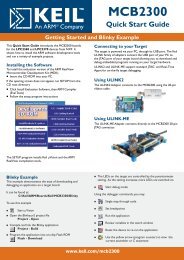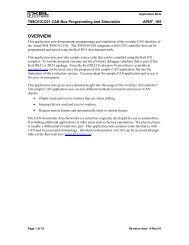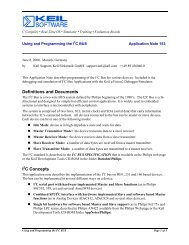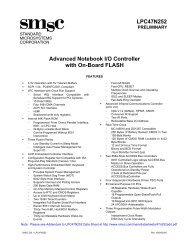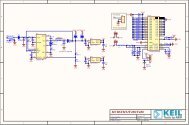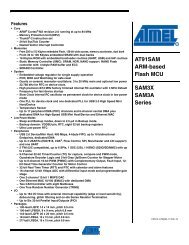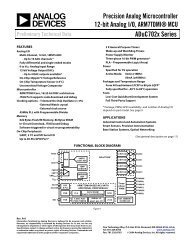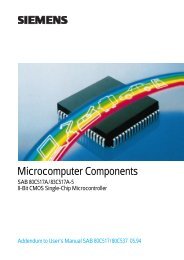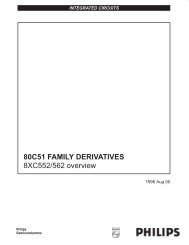You also want an ePaper? Increase the reach of your titles
YUMPU automatically turns print PDFs into web optimized ePapers that Google loves.
Table 14. Pin Description (Continued)<br />
Mnemonic<br />
XTALA1 21 15 49 38 I<br />
4289A–8051–09/03<br />
I/O CEX4: Capture/Compare External I/O for PCA module 4<br />
I/O MOSI: SPI Master Output Slave Input line<br />
<strong>AT89C51ID2</strong><br />
When SPI is in master mode, MOSI outputs data to the slave peripheral.<br />
When SPI is in slave mode, MOSI receives data from the master controller.<br />
Crystal A 1: Input to the inverting oscillator amplifier and input to the internal<br />
clock generator circuits.<br />
XTALA2 20 14 48 37 O Crystal A 2: Output from the inverting oscillator amplifier<br />
XTALB1 2 40 10 19 I<br />
Crystal B 1: (Sub Clock) Input to the inverting oscillator amplifier and input<br />
to the internal clock generator circuits.<br />
XTALB2 1 39 9 18 O Crystal B 2: (Sub Clock) Output from the inverting oscillator amplifier<br />
P2.0 - P2.7 24 - 31 18 - 25<br />
P3.0 - P3.7 11,<br />
13 - 19<br />
P4.0 - P4.7<br />
P5.0 - P5.7<br />
5,<br />
7 - 13<br />
54, 55,<br />
56, 58,<br />
59, 61,<br />
64, 65<br />
34, 39,<br />
40, 41,<br />
42, 43,<br />
45, 47<br />
43, 44,<br />
45, 47,<br />
48, 50,<br />
53, 54<br />
25, 28,<br />
29, 30,<br />
31, 32,<br />
34, 36<br />
11 5 34 25 I RXD (P3.0): Serial input port<br />
13 7 39 28 O TXD (P3.1): Serial output port<br />
14 8 40 29 I INT0 (P3.2): External interrupt 0<br />
15 9 41 30 I INT1 (P3.3): External interrupt 1<br />
16 10 42 31 I T0 (P3.4): Timer 0 external input<br />
17 11 43 32 I T1 (P3.5): Timer 1 external input<br />
I/O<br />
I/O<br />
Port 2: Port 2 is an 8-bit bidirectional I/O port with internal pull-ups. Port 2<br />
pins that have 1s written to them are pulled high by the internal pull-ups<br />
and can be used as inputs. As inputs, Port 2 pins that are externally pulled<br />
low will source current because of the internal pull-ups. Port 2 emits the<br />
high-order address byte during fetches from external program memory and<br />
during accesses to external data memory that use 16-bit addresses (MOVX<br />
@DPTR).In this application, it uses strong internal pull-ups emitting 1s.<br />
During accesses to external data memory that use 8-bit addresses (MOVX<br />
@Ri), port 2 emits the contents of the P2 SFR.<br />
Port 3: Port 3 is an 8-bit bidirectional I/O port with internal pull-ups. Port 3<br />
pins that have 1s written to them are pulled high by the internal pull-ups<br />
and can be used as inputs. As inputs, Port 3 pins that are externally pulled<br />
low will source current because of the internal pull-ups. Port 3 also serves<br />
the special features of the 80C51 family, as listed below.<br />
18 12 45 34 O WR (P3.6): External data memory write strobe<br />
19 13 47 36 O RD (P3.7): External data memory read strobe<br />
- -<br />
- -<br />
Pin Number<br />
PLCC44 VQFP44 PLCC68 VQFP64<br />
20, 24,<br />
26, 44,<br />
46, 50,<br />
53, 57<br />
60, 62,<br />
63, 7, 8,<br />
10, 13,<br />
16<br />
11, 15,<br />
17,33,<br />
35,39,<br />
42, 46<br />
49, 51,<br />
52, 62,<br />
63, 1, 4,<br />
7<br />
Type<br />
I/O<br />
I/O<br />
Name and Function<br />
Port 4: Port 4 is an 8-bit bidirectional I/O port with internal pull-ups. Port 5<br />
pins that have 1s written to them are pulled high by the internal pull-ups<br />
and can be used as inputs. As inputs, Port 4 pins that are externally pulled<br />
low will source current because of the internal pull-ups.<br />
Port 5: Port 5 is an 8-bit bidirectional I/O port with internal pull-ups. Port 3<br />
pins that have 1s written to them are pulled high by the internal pull-ups<br />
and can be used as inputs. As inputs, Port 5 pins that are externally pulled<br />
low will source current because of the internal pull-ups.<br />
13


